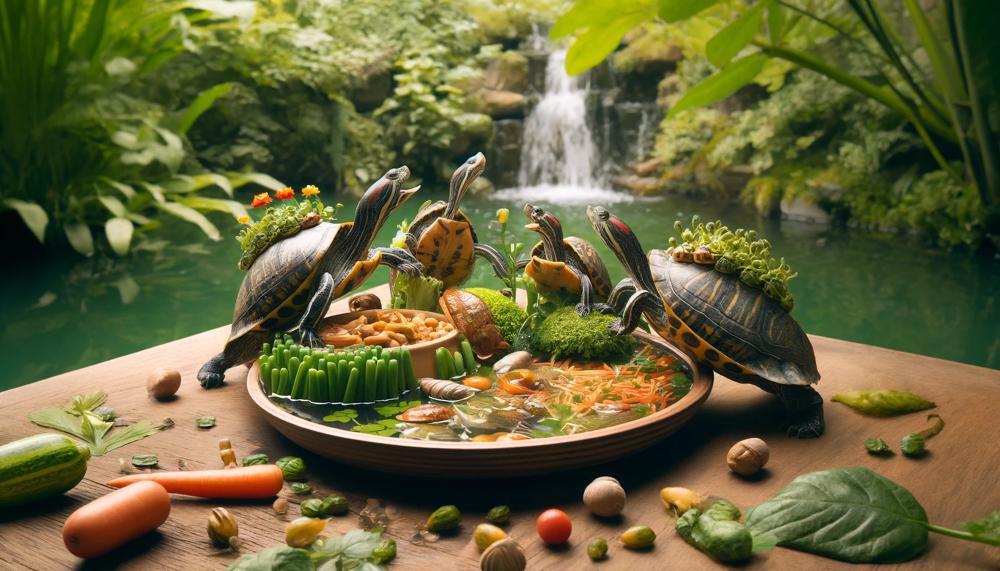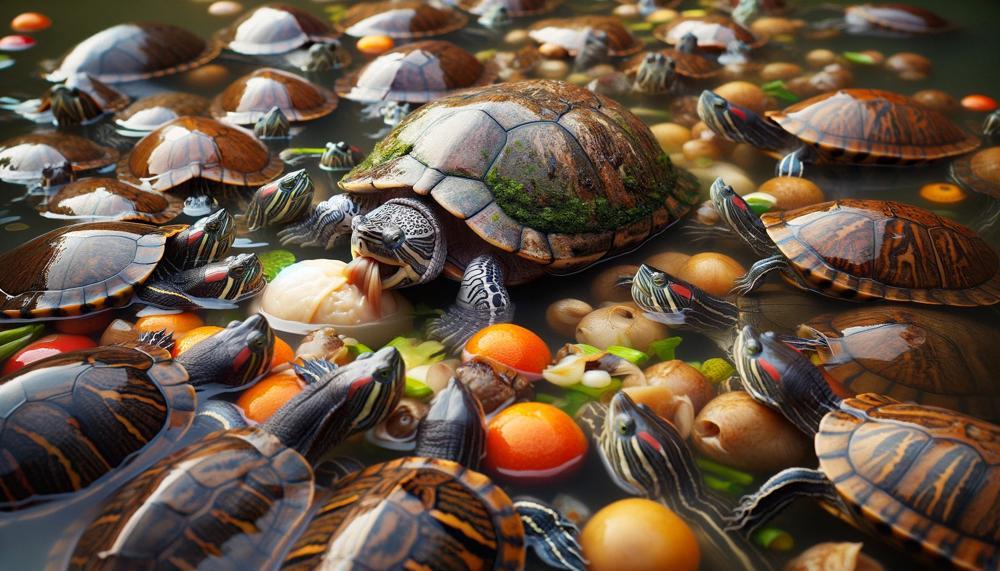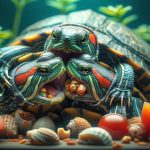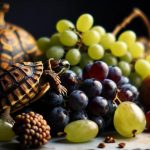What if you knew that the turtles that live in the calm pond in your garden or nearby park might be eating a mix of things that could be harmful to them? This fact, as shocking as it may seem, gives animal lovers and pet owners a lot to think about and be interested in. With pollutants and habitat loss putting more stress on ecosystems, the changes in what pond turtles eat are both interesting and scary.
We’re going to take a deep dive into the complicated balance of nutrition and the secret dangers in these tough animals’ meals today. There is more to a pond turtle’s food than meets the eye. The fresh veggies they eat are just the beginning. Their prey, which they don’t know about, may contain poisons.
So, what do turtles eat in a pond diets toxins?
Turtles in a pond have a diverse diet that varies based on their age and species.
- Adult Turtles: They mostly eat aquatic plants (both floating and submerged), worms, and invertebrates such as snails and insects12. Some small freshwater carnivorous species feed on different aquatic life and small fish.
- Juvenile Turtles: They are primarily carnivorous, requiring high protein for growth.
- Herbivorous Turtles: They feed on pond’s water plants, algae, fallen fruit and leaves, green leafy plants, and vegetables like lettuce, cabbage, carrots, spinach, cucumber, seeds, flowers, leaves, and stems etc.
- Carnivorous Turtles: They feast on insect larvae, snails, worms, small fish, amphibian larvae, crustaceans, dead fish and marine animals, mollusks, frog, shrimp, reptiles, tadpole, sponges, clams, spiders, grasshoppers, carrion, beetles, and crayfish etc.
Prepare to be both enlightened and equipped with the knowledge to make a positive difference in the lives of these charming pond dwellers.
Contents
- 1 What Can I Feed Pond Turtles
- 2 How Often to Feed A Turtle Or Pet/Pond Turtle?
- 3 Can Pond Turtles Eat Lettuce
- 4 What Do Baby Pond Turtles Eat
- 5 Are Turtles Harmful To Ponds/Is It Bad To Have Turtles In Your Pond
- 6 How To Get Rid Of Turtles In A Pond
- 7 How To Keep Turtles In A Pond
- 8 What Do Snapping Turtles Eat In A Pond
- 9 Winding Up
What Can I Feed Pond Turtles
To ensure your pond turtles are munching on safe and nutritious meals, free from any nasty toxins, here’s a guide that walks you through the types of food that should grace their menu.
Remember, variety is the spice of life, even for these shelled friends.
| Food Type | Examples | Notes |
| Leafy Greens and Aquatic Plants | Duckweed, Water Lettuce, Water Hyacinth | Check for chemicals/pesticides |
| Insects and Small Invertebrates | Crickets, Earthworms, Snails, Beetles | Ensure no exposure to harmful substances |
| Calcium-Rich Foods | Cuttlebone, Crushed Eggshells, Calcium Supplements | Balance plant-based and animal-based sources |
| Fruits | Melons, Berries, Apples | Limited amounts to avoid obesity |
| Water Quality | N/A | Regular testing and maintenance required |
How Often to Feed A Turtle Or Pet/Pond Turtle?
To keep your pet or pond turtle thriving, their diet must be both balanced and tailored to their age and species. A mix of commercial pellets, live or frozen insects, and greens like kale and carrots will do wonders. Youngsters require more frequent feedings than their elder counterparts. Offer them a nibble roughly the size of their head; it’s a good gauge for portion control.
Always keep an eye on their response to meals and adjust as needed. If they turn up their nose at dinner or seem under the weather, a vet’s advice is golden.
| Age Group | Feeding Frequency | Notes |
| Baby Turtles | Daily | Small, manageable portions to support rapid growth. |
| Juvenile Turtles | Every Other Day | Larger portions as they’re still growing, but less frequently than babies. |
| Adult Turtles | 2-3 Times a Week | Prevent overfeeding; adults have slower metabolism. |
Adjust the meal size and frequency based on your turtle’s specific needs and reactions to their diet. Keep their living conditions spotless, with proper lighting and heating, to aid in digestion and overall health.
Can Pond Turtles Eat Lettuce
Indeed, pond turtles can safely nibble on lettuce, with a preference for the darker, leafier types like romaine. Let’s dive into the specifics, shall we? Firstly, it’s worth mentioning that while lettuce can be a healthy snack, it shouldn’t be the star of the show in their diet.
Occasional servings ensure they get hydration and some beneficial nutrients without missing out on the essentials. Iceberg lettuce, on the other hand, is akin to giving them a bowl of crunchy water – low in nutrients, so best to steer clear.
| Lettuce Type | Benefit | Frequency |
| Romaine | Hydration + Nutrients | Occasionally |
| Iceberg | Low Nutritional Value | Rarely/Avoid |
What Do Baby Pond Turtles Eat
Baby pond turtles, those small, curious creatures that paddle through the waters with an eagerness for life, embark on a dietary journey that’s both fascinating and crucial for their development. They’re omnivores, meaning their meals consist of a mishmash of plant and animal matter.
Let’s dive into the specifics of their diet and how the silent threat of toxins in their habitat can sway their nutritional balance.
Suitable Foods for Baby Pond Turtles
| Food Type | Examples | Benefits |
| Plants | Duckweed, water lettuce, water hyacinth | Rich in vitamins and minerals, aids in digestion |
| Animals | Small insects, worms, snails, crustaceans | High in protein, essential for growth and shell development |
| Supplements | Commercial turtle pellets | Formulated to meet nutritional needs, including calcium and vitamins A and D |
The Shadow of Toxins
The tranquility of a pond can be deceptive, as it may harbor toxins that threaten our tiny turtles. From pesticides whisked away by the rain to the sinister seep of chemical runoff from nearby fields, these substances can turn a turtle’s haven into a hazardous zone.
When turtles ingest food tainted by such toxins, the repercussions can be severe, affecting everything from their neurological function to their ability to absorb essential nutrients.
This exposure can stunt their growth, hinder shell development, and even compromise their immune system, making them more vulnerable to diseases.
Strategies for a Safe Diet
To shield these vulnerable beings from the invisible menace of toxins, diligence is our best tool. Ensuring their pond is a sanctuary, free from pollution and chemical intrusion, is paramount. Opting for organic farming practices nearby, regular cleaning of their aquatic home, and vigilant monitoring of water quality can make a world of difference.
When it comes to their diet, variety is not just the spice of life but a lifeline. Mixing high-quality commercial pellets with fresh, uncontaminated plant and animal matter ensures they receive the plethora of nutrients needed to thrive against the odds.
By nurturing them with a diet rich in diversity and shielded from the threats lurking in their waters, we foster a robust start for these fascinating creatures.
Are Turtles Harmful To Ponds/Is It Bad To Have Turtles In Your Pond
Turtles can play a pivotal role in maintaining the health and equilibrium of pond ecosystems. Their presence is often a mark of a vibrant aquatic environment, as they contribute significantly to the ecosystem’s dynamics.
By munching on plant matter, deceased fish, and aiding in controlling the proliferation of aquatic weeds, turtles help in keeping the waters clear and prevent the spread of disease. Yet, it’s a delicate balance, as an overabundance of these reptilian inhabitants might tip the scales negatively, impacting both the pond’s biological health and water quality.
The Role of Turtles in Pond Ecosystems
- Natural Clean-Up Crew: Turtles act as the pond’s clean-up crew by eating dead fish and plant matter, which helps in maintaining a clean and healthy environment.
- Weed Control: Their diet also includes aquatic weeds, thus helping in managing weed growth and keeping the ecosystem balanced.
Balancing Turtle Populations
While turtles are beneficial, an excess of their population can strain the pond ecosystem. Here’s a detailed look at how turtles impact pond ecosystems, both positively and negatively:
| Positive Impacts | Negative Impacts | Management Strategies |
| Eating dead fish and plant matter keeps the pond clean. | Overpopulation can degrade water quality. | Regulate turtle numbers through relocation or barriers. |
| Control of weed growth. | High turtle numbers can disrupt the food chain. | Implement physical barriers like fencing or netting. |
| Helps in disease prevention by cleaning up. | Wild turtles may introduce diseases. | Monitor and manage wild turtle populations carefully. |
How To Get Rid Of Turtles In A Pond
When managing the presence of turtles in a pond, it is crucial to employ methods that are both effective and humane.
Below is a detailed guide on how to remove turtles from a pond without causing them harm, taking into account their ecological roles and legal protections.
| Method | Description | Consideration |
| Box Traps | Non-lethal traps placed in water with bait. | Requires monitoring to ensure turtles are not stressed. |
| Basking Traps | Traps that capture turtles during their basking. | Humane but requires daily checking. |
| Barrier Installation | Preventive measure to stop new turtles from entering. | Permanent solution, but initial setup is labor-intensive. |
| Floating Docks | Alternative sunbathing spots to attract turtles away from sensitive areas. | Effective but requires space and maintenance. |
Implementing these methods thoughtfully ensures the humane treatment of turtles while maintaining the ecological balance of your pond environment.
How To Keep Turtles In A Pond
When devising a diet for pond turtles, consider these pivotal factors to sidestep toxins and bolster their health:
Species and Age Specifics
Different species and ages necessitate tailored diets. Research your turtle’s species for precise needs.
Habitat Harmony
Match the diet to the turtle’s environment, ensuring food sources are apt for their living conditions.
Mimicking Natural Diets
Emulate their wild diet, including a mix of plant and animal matter, to mirror natural eating habits.
Balanced Nutrition
Offer a varied diet encompassing veggies, fruits, protein, and necessary supplements.
Safety in Food Sources
Avoid human foods and toxic items. Opt for turtle-specific feeds or safe, fresh produce.
Diversity in Diet
A varied diet is key. Rotate foods to provide all essential nutrients.
Health Monitoring
Regular check-ups with a vet can catch dietary issues early, ensuring prompt adjustments.
Pond Turtle Dietary Table
| Aspect | Detail | Note |
|---|---|---|
| Species and Age | Tailor diet to specific species and age | Young turtles often need more protein |
| Habitat Compatibility | Align food choices with habitat features | Include items found in their natural habitat |
| Natural Diet | Blend plant and animal-based foods | Reflects their opportunistic feeding in the wild |
| Nutritional Balance | Mix of vegetables, fruits, proteins, supplements | Ensures comprehensive nourishment |
| Safe Food Sources | Turtle-specific foods or safe produce | Avoids toxins and harmful substances |
| Diet Variety | Rotate foods for nutrient diversity | Prevents nutritional deficiencies |
| Health Checks | Regular veterinary consultations | Adjusts diet as needed for health and growth |

By adhering to these guidelines, you’ll ensure your pond turtles thrive, avoiding toxins and promoting robust health.
What Do Snapping Turtles Eat In A Pond
Snapping turtles, those stalwart inhabitants of ponds, embody the essence of opportunistic feeders, embracing an omnivorous diet that reflects the richness and variety of their aquatic realms. Their fare is as diverse as the pond’s life, from the stealthy ambush of fish to the pluck of a wandering bird, the snag of aquatic insects, and the serene graze on algae and tender vegetation.
Below, we delve into the cornerstone components of their diet and the shadow cast by toxins within these waters.
Main Food Sources for Snapping Turtles in a Pond
| Food Type | Description | Importance |
| Aquatic Vegetation | Algae and water plants | Supplies essential vitamins and fiber |
| Fish | Live or dead, including smaller species | Rich source of protein |
| Invertebrates | Aquatic insects, snails, and worms | Protein and mineral-rich snacks |
| Small Amphibians and Reptiles | Frogs, tadpoles, and even small turtles | Additional protein and fat sources |
| Carrion | Dead animal matter | Helps keep the pond clean; provides easy meals |
| Birds and Small Mammals | Occasional prey, caught by surprise | High in protein and fats |
Impact of Toxins on Health
While snapping turtles are adept at thriving in diverse environments, their resilience faces a challenge from the pollutants and toxins infiltrating their ponds. These contaminants, stemming from urban runoff, agricultural waste, and industrial discharges, weave into the web of pond life, accumulating in the turtles through the food they consume.
Toxins such as heavy metals, pesticides, and plastic residues can induce a range of adverse effects:
- Metabolic Disruption: Affects the turtles’ ability to process food and convert it into energy efficiently.
- Reproductive Harm: Leads to decreased fertility rates and hampers the development of offspring.
- Shell Deformities: Pollutants like endocrine disruptors can lead to shell malformations in growing turtles.
- Immune System Suppression: Makes turtles more susceptible to diseases and parasites.
The legacy of these hard-shelled foragers is not just their ability to adapt but their struggle against the creeping peril of pollution.
Winding Up
| Aspect | Risk | Consequence |
|---|---|---|
| Food Chain Contamination | Ingestion of contaminated flora and fauna | Internal toxin buildup, affecting health and survival |
| Immune System | Reduced immunity due to toxin exposure | Increased vulnerability to diseases and infections |
| Reproductive Health | Toxins affecting reproductive systems | Reduced fertility, affecting population sustainability |
| Behavioral Changes | Altered activities due to toxic exposure | Diminished ability to forage, evade predators, or reproduce |
| Bioaccumulation | Long-term toxin accumulation | Chronic health issues, potentially leading to premature death |
| Ecosystem Impact | Transfer of toxins through the food web | Decline in biodiversity and disruption of ecosystem balance |
- Food Chain Contamination: Turtles munch on plants and critters in their pond, but when these snacks are tainted with toxins, the turtles ingest these poisons too. This grim diet leads to a buildup of harmful substances in their bodies, messing with their health and chances of survival.
- Immune System Troubles: The nasty chemicals in the water can weaken a turtle’s defence against illnesses, making them an easy target for diseases and infections. This sorry state means more turtles falling ill and fewer bouncing back.
- Reproductive Ruckus: The toxic stew in their homes doesn’t just sicken turtles; it can also throw a spanner in their baby-making works. When the toxins mess with their reproductive bits and pieces, it spells trouble for future turtle generations.
- Behavioural Blips: Feeling under the weather from all those toxins, turtles might lose their zest for life. They become sluggish, struggling to scavenge food, dodge predators, or woo a mate, which could spell disaster for their survival.
- Bioaccumulation Blues: Over time, these toxins don’t just visit; they move in and accumulate, leading to long-term health woes for the turtles. This slow and steady poisoning can end in tragedy, with turtles dying before their time.






